Hollywood director James Cameron to pilot submarine to the bottom of Mariana Trench
National Geographic, Rolex, Scripps, NASA, among others involved in exciting expedition
Famed Hollywood filmmaker and National Geographic Explorer-in-Residence James Cameron is getting ready to lead an expedition to the deepest part of our planet in the coming weeks: he will descend into the depths of the Mariana Trench, an area dubbed the “Challenger Deep”.
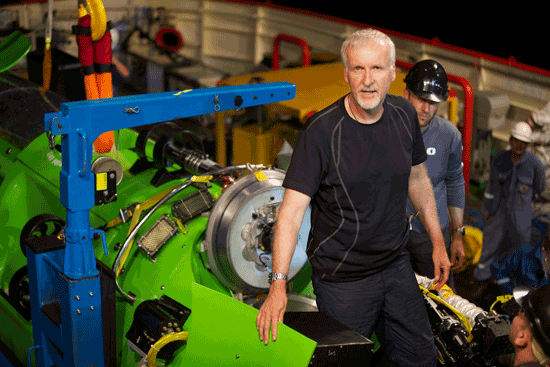
Explorer and filmmaker James Cameron emerges from the hatch of DEEPSEA CHALLENGER during testing of the submersible in Jervis Bay, south of Sydney, Australia. In the coming weeks, the vessel will travel to the bottom of the Mariana Trench and is the centerpiece of DEEPSEA CHALLENGE, a joint scientific project by Cameron, the National Geographic Society and Rolex to conduct deep-ocean research. (Photo by Mark Thiessen/National Geographic)
Cameron will do this in a custom-built, one-man sub referred to as the “DEEPSEA CHALLENGER.” It will travel seven miles below the Pacific Ocean, where the director of such movies as Avatar , Titanic , and The Terminator , will shoot 3D video, capture HD images, and record as much data as possible.
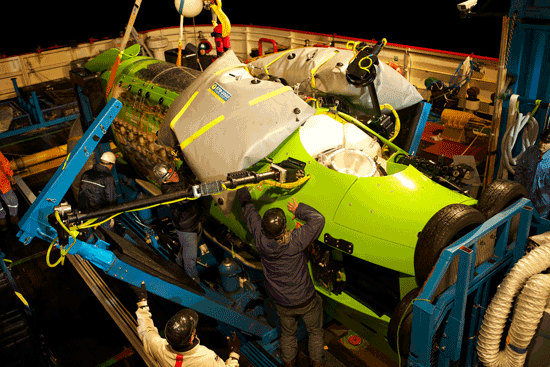
Crews prepare DEEPSEA CHALLENGER for its first test in the ocean at Jervis Bay, south of Sydney, Australia. In the coming weeks the submersible will travel to the bottom of the Mariana Trench as the centerpiece of DEEPSEA CHALLENGE, a joint scientific project by explorer and filmmaker James Cameron, the National Geographic Society and Rolex to conduct deep-ocean research. (Photo by Mark Thiessen/National Geographic)
Here’s a look into the upcoming expedition.
The Mariana Trench
The Mariana Trench is a 1,500 mile-long scar that runs along the Pacific seafloor. At Challenger Deep, the trench goes down 6.8 miles. For reference, if Mount Everest were to be placed here, its peak would be one mile below the surface of the water.
Over the past few decades, biologists have caught glimpses of the unfamiliar inhabitants that live down here. They did this by lowering dredges on long lines which, when carried up, brought with them thousands of strange-looking worms and sea cucumbers. More recently, robot cameras have been sent down around the area, where they spied ghostly fish with sinuous tails.
Cameron will be just the third person to dive to the bottom of the Mariana Trench, following former Navy lieutenant Don Walsh and famed Swiss oceanographer Jacques Piccard who, together, made the descent in their 60-foot Trieste sub back in 1960.
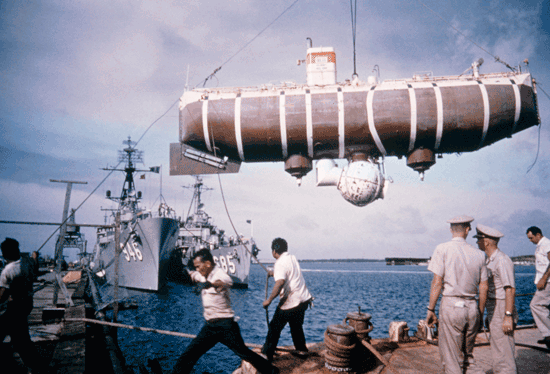
Swinging above the docks in Guam’s Apra Harbor is the Trieste , the submersible that took Don Walsh and Jacques Piccard on the first and only successful manned dive to the bottom of the Mariana Trench. In the coming weeks, 52 years later, explorer and filmmaker James Cameron will attempt to make the second successful manned dive to the deepest part of the ocean. The dive will mark the launch of DEEPSEA CHALLENGE, a joint scientific project by Cameron, the National Geographic Society and Rolex to conduct deep-ocean research. (Photo by Thomas J. Abercrombie)
Here’s how Cameron’s expedition stacks up against the Trieste:
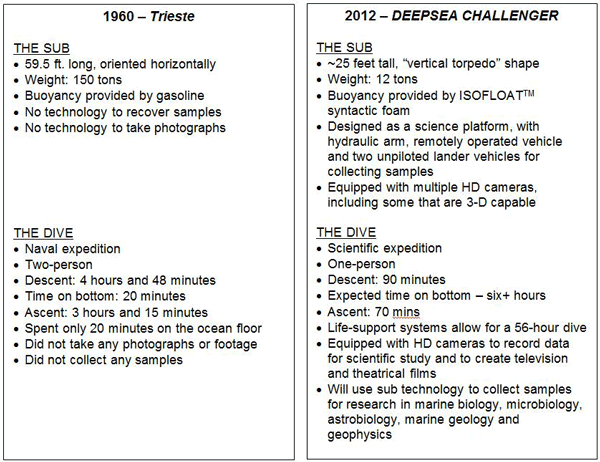
The sub
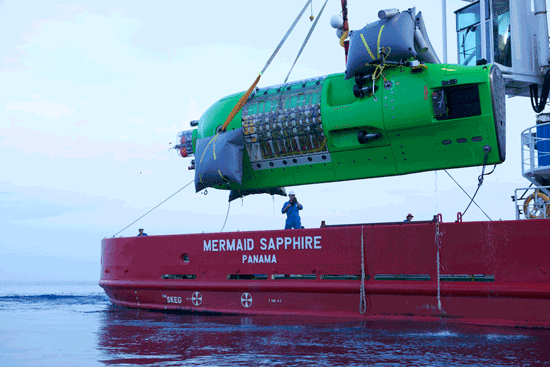
DEEPSEA CHALLENGER, the submersible designed by explorer and filmmaker James Cameron and his engineering team to travel to the bottom of the Mariana Trench, is lowered into the water for testing off the coast of Australia. The vessel is the centerpiece of DEEPSEA CHALLENGE, a joint scientific project by Cameron, the National Geographic Society and Rolex to conduct deep-ocean research. (Photo by Mark Thiessen/National Geographic)
The DEEPSEA CHALLENGER is expected to stay on the seafloor for about six hours. While there, Cameron will record video with a series of 3D, high-definition cameras. The perpetually dark area will be illuminated with an 8-foot-tall array of LED lights that has the ability to illuminate up to 100 feet of clear water. Cameron will control both using a hydraulic system. He will also have control of a special robotic arm that will allow him to collect samples for research in biology, microbiology, astrobiology, marine geology, and geophysics.
Small design
There are three main sections to the sub: there’s the beam, which is the single biggest component. Below that is Cameron’s pilot sphere and below that is a section that stores all of the scientific gear.
The sub is one of a kind and took eight years to make. It operates vertically and was purposely designed to be as small as possible so as to better withstand the immense pressure of being underwater that deep (roughly 16,000 pounds per square inch).
In fact, the 6-foot-2-inch Cameron will be operating the sub in an area that has a diameter of less than four feet. Besides snacks and a change of warmer clothing (it will get very cold down there), there are no amenities on board.
Finding the right foam
One of the headaches that the team ran into was finding foam with which to construct the sub. Most materials that they tried either cracked, warped, compressed, lost buoyancy, or otherwise did not display enough tensile strength to operate that deep underwater.
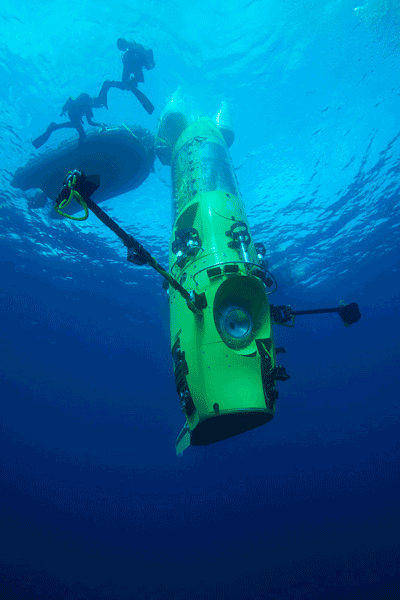
The DEEPSEA CHALLENGER submersible begins its first 2.5-mile (4-km) test dive off the coast of Papua New Guinea. The sub is the centerpiece of DEEPSEA CHALLENGE, a joint scientific project by explorer and filmmaker James Cameron, the National Geographic Society and Rolex to conduct deep-ocean research. (Photo by Mark Thiessen/National Geographic)
Frustrated, the team decided to create a syntactic foam, which has since been named “ISOFLOAT” and is already patented. It’s made up of millions of hollow glass microspheres, altogether suspended in an epoxy resin. In total, 70% of the sub’s volume is made up of ISOFLOAT.
Ascent/Descent
The ISOFLOAT foam plays a big role in getting Cameron back up to the surface. During the descent, the sub is outfitted with about 1,000 pounds of steel plates. When it’s time for the ascent, Cameron will flip a switch that will turn on an electromagnetic system that abandons the plates, thus allowing the sub to rise to the surface.
Should any issues arise, there are a series of solutions planned out:
• If there’s a power failure, the plates will fall away immediately.
• If plates don’t disengage, the wire connecting them to the sub will corrode after 12 hours.
• Cameron can use a heat-based method to break the bolts within the sub from holding the plates.
• If this doesn’t work, bolts can be broken electromagnetically via signal sent from the above-surface team.
Moving around
While on the seafloor, Cameron will be able to pilot the sub using joysticks that command its 12 propeller-driven thrusters. He will be able to move the sub up and down, side to side, and even hover in place, a system that the team calls “Auto Altitude”.
In terms of speed, Cameron will be able to move at 3 knots, and travel upwards at about 2 knots. The sub is capable of turning on a dime, and the whole system is super-quiet so as to not disturb the local wildlife.
Making the electronics and batteries water and pressure-proof
The DEEPSEA CHALLENGER will rely on three buses of battery power during the dive (though it can operate on just one): that’s enough on-board battery to power two-to-three electric cars.
More specifically, 70 battery packs will be mounted in the sub’s walls, with each one spaced far enough apart from the other so as to not disrupt the foam as it shrinks under the ocean’s pressure (the sub is expected to shrink by about 1%).
Each battery will sit inside a silicon oil-filled, bread-loaf-sized plastic box. A problem that the team ran into is that silicon fluid shrinks under pressure. Their solution was to place a small medical drip bag inside each pack and as the pressure increases, the bag inflates with seawater; as the sub ascends, the seawater is expelled. This allows the packs to be exposed to the high pressure surrounding without affecting the battery. It also allowed the engineers to avoid having to build heavy, pressure-resistant housing for all the batteries, too.
Communication
Cameron will narrate a dive log into two 3D cameras during the expedition. He’ll be in touch with his above-surface crew via a 19-mile under water range, and can communicate with them via text message, too.
Location
There are several locating systems to assist the team with finding the sub after it surfaces:
• An acoustic navigation system allows the ship to track the sub as it surfaces.
• There’s a pair of LED beacon lights on the sub, both of which are visible at night for several miles. They’re powered by a dedicated battery system and can last up to 16 hours.
• A strobe light atop the sub can flash for 30 hours.
• The sub includes two separate GPS beacons in glass, pressure-resistant spheres:
– One uses a satellite system to send the sub’s coordinates to the team’s ship.
– The other uses marine VHF to broadcast the sub’s coordinates at ranges otherwise limited by sight.
• A radio direction finder system is included, too.
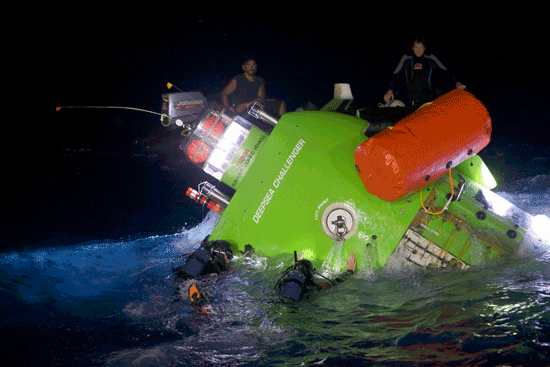
Crews continue in-water testing in Papua New Guinea of DEEPSEA CHALLENGER, the submersible that explorer and filmmaker James Cameron will pilot to the bottom of the Mariana Trench. The vessel is the centerpiece of DEEPSEA CHALLENGE, a joint scientific project by Cameron, the National Geographic Society and Rolex to conduct deep-ocean research. (Photo by Mark Thiessen/National Geographic)
Between monitoring and controlling the sub, batteries, thrusters, life support, navigation, 3D cameras, robotic arm, LED lights, and more, there are over 180 systems being used for this project.
Expedition hopes
In addition to Cameron’s underwater work, the team will also be dropping unmanned “landers” to the trench bottom before Cameron’s descent. They look kind of like skinny phone booths and are 13-feet tall. Each one’s equipped with cameras and will carry bait in hopes of capturing sea creatures in plastic cylinders, which can then be retrieved by the team later on when they surface.
In addition to learning more about this unexplored part of our planet, the team is hoping that this project will also shed some light on natural disasters and the emergence of life on Earth (some scientists suggest that mud volcanoes near the Mariana Trench could have served as incubators for the first life-forms on Earth).
Film
The DEEPSEA CHALLENGE expedition will be made into a 3D feature film. It will subsequently be broadcast on the National Geographic Channel, and documented in National Geographic magazine.
Cameron plans to also collaborate with National Geographic to create broad-based educational outreach materials pertaining to this expedition.
Additional support
In addition to National Geographic and Rolex, who are together sponsoring the project, Scripps Institution of Oceanography, UC San Diego, is the DEEPSEA CHALLENGE Project’s primary science collaborator. Additionally, the team is collaborating with the University of Hawaii, NASA’s Jet Propulsion Laboratory, and the University of Guam. Additional funding has been provided by the Alfred P. Sloan Foundation, which supports original research and public understanding of science, technology, engineering, and mathematics.
One last thing . . .
National Geographic put together a great website that fully explores all of the DEEPSEA CHALLENGER’s systems, and provides further information on how this mission came to fruition. Check it out at deepseachallenge.com ■
Advertisement
Learn more about Electronic Products Magazine





